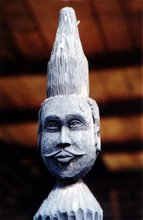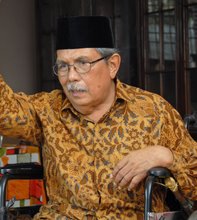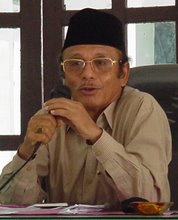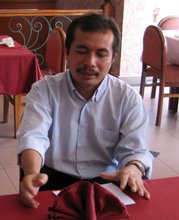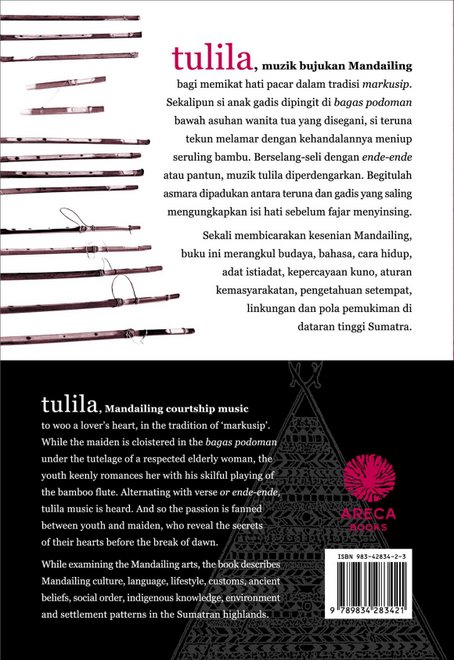 The authors presenting a copy of the Kinta Valley book to the Regent of Perak, Raja Dr. Nazrin Shah, who launched the book.
The authors presenting a copy of the Kinta Valley book to the Regent of Perak, Raja Dr. Nazrin Shah, who launched the book.Kedua pengarang mempersembahkan buku Kinta Valley kepada Raja Muda Perak, Raja Dr. Nazrin Shah, yang melancarkan karya tersebut.
Foto Syaharin Abidin
JMBRAS Vol: 78 Part 2 2005
KINTA VALLEY:
PIONEERING MALAYSIA'S MODERN DEVELOPMENT
by KH00 SALMA NASUTION AND ABDUR-RAZZAQ LUBIS
With a preface by WANG GUNGWU
Published by the Perak Academy, 2005. i-viii + 384 pp.
Extensive black & white photos,
327 colour plates. ISBN 983-42113-0-9 (hardback), RM180
This handsomely produced book provides the fullest account ever written, or likely to be written, on the history of the Kinta Valley. The earliest history, which is covered in little more than two pages, relates the Hindu and Buddhist influences on the area, revealed in the discovery of religious artefacts in the course of later mining activities.
The first written records emerge around AD 1500 when Portuguese and later Dutch influence began to be exercised in the area. By the eighteenth century, tin had emerged as the crucial resource of the state, promoting political machinations between the Dutch East India Company and successive Sultans.
The authors skate relatively lightly over the years of British intervention in the state. The story in any case is relatively well known, and much of the action took place outside the Kinta district, to the north and west.
Having comparatively briefly established the early history leading to the opening of the Kinta Valley, the central portion of the book examines, thematically at first, the development of different aspects of life in the valley: rivers, roads, railways, fire prevention and health, and, briefly, agriculture. A more detailed analysis of the agricultural development of the area would have been welcome. From the handsome coloured map of 1912 on pp. xxiv-xxv at the end of the book, it is clear that agriculture was, in the early years at least, a significant feature in the economy of the valley. The authors have been particularly well served by the Perak Government Gazette which they have mined very extensively for material. They have also not disregarded contemporary accounts, and more modern publications, such as the comparatively recent account of Charles Alma Baker, an early pioneer of rubber in the area.
Kinta is of course best known for its massive tin production in the late nineteenth and early twentieth centuries. Sections on tin and the potted histories of towns in the valley, whose fortunes were so closely tied to this metal, form an important and central feature of the book. Indeed the accounts of the different techniques used by the Malays, Chinese, and Europeans, frequently and vividly illustrated by old black and white photographs, bring the industry to life in a way which other, more austere and scholarly works have singularly failed to do. This section of the book at least, drawing on a wide range of sources from the early French mining engineers to academic works of the second half of the twentieth century, provides as good a summary as can be found of the fortunes of the Perak tin industry.
Significant coverage is given to the histories of the individual villages in the area. Most of them sprang up as tin rush towns on discovery of rich lodes of tin, and many subsequently became little more than ghost towns, like Papan. The accounts chronicle the building of mosques and temples, and mention the leading citizens.
Ipoh of course was the pre-eminent, and most durable, of the towns, and the book traces in some detail its beginnings from the end of the nineteenth century up to the end of the Emergency. Special chapters are devoted to the Japanese Occupation and the Emergency. However, surprisingly no account is given of the reasons for the collapse of the tin industry in the 1980s.
These are comparatively minor quibbles compared to the breadth and scope of the book overall. This scope has been enriched by the Mandailing perspective of AbdurRazzaq Lubis, who has studied in detail from his own rich family sources the contribution of the Mandailings in the nineteenth and twentieth centuries to the development of Perak. The last two chapters deal with the environment and the Orang Ash. The limestone outcrops which are such a striking feature of the area support a highly specialized vegetation, adapted to the harsh, often dry conditions. Many of these species are endemic, found nowhere else in the world, and in some cases restricted to a single outcrop. It is important that they be conserved. The final and substantial chapter on the Orang Ash traces their associations in the valley from precolonial times, when they were often enslaved by the Malays, through the colonial period. They assumed strategic importance during the Emergency when the communist terrorists and the government competed to enlist their support.
The book concludes with a 32-page colour supplement which shows primarily modern photographs of surviving buildings (many threatened, alas, and at-least one destroyed since the book was written) and views of the area.
There is a comprehensive if at times idiosyncratic bibliography: T. J. Danaraj under T. rather than D. and an index. The book is excellently produced and generally well edited, p. 204 `internecine' for `interwar' being a notable exception.
Lucky the district to have its history so comprehensively and excellently catalogued as has been done for Kinta.
Malaysian Branch of the H. S. BARLOW
Royal Asiatic Society
